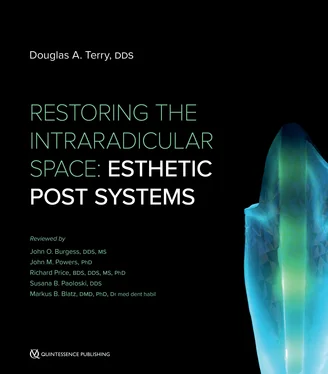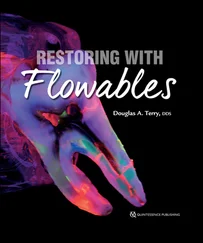GUIDELINES FOR RESTORING THE INTRARADICULAR SPACE
Preoperative considerations
• Consideration should be taken on root canal fillings that may appear technically acceptable on radiographic review but have been exposed to bacterial infiltration for more than 30 days. 44 ,658 If the coronal seal has been open or leaking for more than 30 days, the root canal treatment should be evaluated carefully.
• A good-quality endodontic filling and restorative margins improve the treatment outcome.531 ,659
• Restorative treatment plans should be completed prior to the endodontic phase and should be executed as soon as possible after endodontic treatment.659
• Generally, clinical failure of post and core restorations are associated with restoration geometry, occlusal loads, biomaterial, 54and quality of the adhesive interface.
• ETT with post and core rehabilitation are more susceptible to cervical fracture when there is reduced periodontal support. 54
• The predictability of ETT to support a distal-extension removable partial denture, a precision attachment, or a cantilevered fixed partial denture is less successful clinically.660 ,661 Fractures in these terminal abutment teeth occur more often in post-restored ETT.662
• The placement of a post system should not be considered without exception for ETT. 100
Post and core
• Post and core systems with an elastic modulus similar to that of dentin form a mechanically homogenous unit or monoblock system with improved biomechanical performance 51and minimize the risk of fracture.365 ,400
• There are considerable differences in the quality, mechanical properties, and retention produced by various post systems. Post selection for an individual case should depend on clinical and laboratory reports evaluating post systems.459 ,464
• Metal posts have a high elastic modulus (stiffness) compared to dentin,350 and the risk for root fracture is increased.351
• Fiber-reinforced posts generate lower stresses than metal posts.114 ,457
• Fractures that occur as a result of using fiber-reinforced post systems are more often repairable than fractures with metal posts.353
• The mechanical properties of the resin matrix and the interfacial adhesion between the fibers and the matrix may primarily contribute to the flexural strength of glass fiber posts.663
• Anatomical posts (ie, fiber, metal) relined with resin composite result in the highest fracture resistance of the restored tooth compared to other methods.185
• ETT restored with fiber-reinforced composite posts have lower and more favorably distributed stresses than teeth with metal posts. 111 ,355 ,367 –372
• Non-noble alloy metal post systems can corrode in the oral cavity and are associated with root fractures. 19 ,397
• The radiopacity of the fiber posts varies, and this property is important in detecting and determining the position and length of the post in the post channel during standard radiographic procedures.200
Preparation
• Conservation of tooth structure when restoring ETT is as important as the selection of biomaterial for creating an optimal biomechanical behavior.185
• The preservation of 4 to 5 mm of gutta-percha is necessary for an adequate apical seal.201 ,296 –307 Furthermore, a poor coronal seal may contribute to clinical failure.295 ,664
• Large endodontic openings reduce the amount of dentin and weaken the structural integrity of the tooth216 and can be responsible for horizontal and vertical root fracture.291 ,321 –326
• 1 mm of dentin wall thickness is required to prevent root fracture and to properly support the core.159 ,295
• Post length should be at least the length of the crown or two-thirds the length of the remaining root.185
• Diamond bur preparation of the post channel in comparison to a carbide bur allows the etching procedure to remove the smear layer more efficiently with more open dentin tubules and with fewer smear layer remnants.220
• It is recommended that the root morphology be considered for each tooth type prior to preparation of the post channel. Mandibular incisors, maxillary second premolars, and the distal root of mandibular molars have mesiodistal concavities and may be narrower mesiodistally than they appear in the radiograph.327
• Cemented post retention depends more on increasing post length than increasing the post diameter.665
Ferrule effect
• The fundamental requirement for reinforcement of the endodontically treated tooth is the ferrule effect.
• The ferrule effect provides mechanical stabilization by optimizing the resistance and retention form of an extracoronal restoration for an endodontically treated tooth.301 Clinical success and fracture resistance of ETT is greatly improved with a 2-mm ferrule placed 360 degrees around the tooth.381 ,562
• To provide a 2-mm ferrule with inadequate tooth structure above the bone without violating biologic width, use surgical crown lengthening and/or orthodontic extrusion.
• A minimum of at least 3 mm should be present between the crown margin and the alveolar bone to avoid impingement on the coronal attachment of the periodontal connective tissue.531 Furthermore, to attain an adequate ferrule dimension of 1.5 to 2 mm and maintain a biologic width of 3 mm requires a restorative dimension of 4.5 to 5 mm of supracrestal tooth structure.
• Crown placement of a 2-mm circumferential coronal tooth collar on the core buildup provides mechanical resistance for the endodontically restored tooth complex. 70 ,189 ,218 ,281 ,401 ,402
• Extracoronal restorative margins should be placed at least 1 to 2 mm onto sound tooth structure to increase fracture resistance to the underlying restorative complex. 44
• Orthodontic extrusion may be preferable to crown lengthening because it can result in smaller change in crown-to-root ratio. 81Orthodontic extrusion generally preserves more hard and soft tissue, provides a more preferable crown-to-root ratio, and a more favorable biomechanical behavior.
• Supracrestal fiberotomies have been recommended587 ,591 ,601 ,614 ,618 ,628 ,629 once a week during the forced eruption and post procedure to stabilize and prevent relapse.629
• More walls increase the fracture resistance; more important, however, is the location of the wall in relation to the biting force.
• In a post-restored tooth, the ferrule reduces the maximum tensile stresses in the crown and the root.666
Adhesion
• It is recommended that fiber-reinforced composite posts be luted with an adhesive resin cement. 52 ,346 ,479 ,481
• Inadequate polymerization throughout an adhesive post system can result in gap formation, recurrent caries, marginal leakage, and failure of the restorative complex.507 ,667
• A thickness of 0.3 mm of resin cement shows the most favorable stress distribution.431
• Adhesive placement of a fiber-reinforced post improves the fracture resistance of ETT when fewer than two cavity walls remain.418
• The density and diameter of dentinal tubules decreases from coronal to apical.496 ,668 ,669
• A time delay of 5 minutes during the bonding procedure of a fiber-reinforced post with a dual-cured resin cement improves the mechanical properties of the resin cement and decreases stress generated by post-gel shrinkage.670 ,671
• A quality coronal seal to prevent bacterial contamination is required for long-term success of ETT.531 A resin-modified glass ionomer or composite is recommended for occlusal access closure.
• To compensate for the insufficient light diffusion in the restricted post space, a high-intensity light-curing unit should be used and/or the irradiation time of adhesive systems/resin cements should be increased to improve adhesion to root dentin.230 ,244 ,249
Читать дальше












